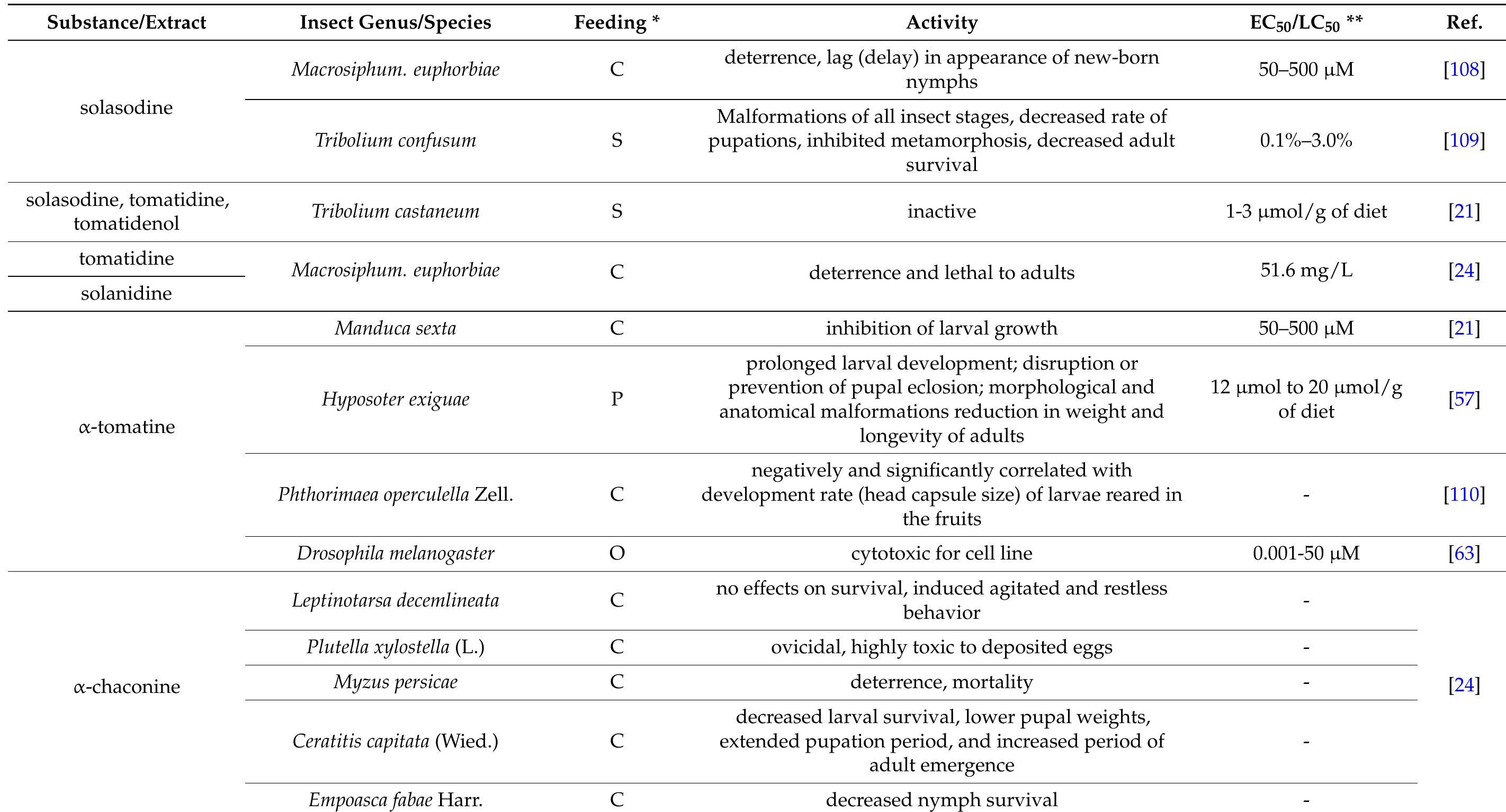A Review of Bioinsecticidal Activity of Solanaceae Alkaloids (original) (raw)
Abstract
Only a small percentage of insect species are pests. However, pest species cause significant losses in agricultural and forest crops, and many are vectors of diseases. Currently, many scientists are focused on developing new tools to control insect populations, including secondary plant metabolites, e.g., alkaloids, glycoalkaloids, terpenoids, organic acids and alcohols, which show promise for use in plant protection. These compounds can affect insects at all levels of biological organization, but their action generally disturbs cellular and physiological processes, e.g., by altering redox balance, hormonal regulation, neuronal signalization or reproduction in exposed individuals. Secondary plant metabolites cause toxic effects that can be observed at both lethal and sublethal levels, but the most important effect is repellence. Plants from the Solanaceae family, which contains numerous economically and ecologically important species, produce various substances that affect insects b...
Figures (12)
Figure 1. Structure of the major glycoalkaloids of the potato, eggplant and tomato: aglycones (a) and carbohydrate moieties (b). are attached to the aglycone, e.g., solasodine in the eggplant, thereby producing the glycoalkaloids solamargine and solasonine (Figure 1). The tomato plant produces the compounds a-tomatine and dehydrotomatine, which differ in only the presence or absence of a double bond in the ring structure. In domestic potato plants, x-solanine and «-chaconine are usually the two dominant glycoalkaloids [47], but several other glycoalkaloids may also be found in wild species [48].
—_— ee ne ee From an agroeconomic point of view, decreased reproduction (lower number of laid eggs and lower fertility and fecundity) is one the most important insecticidal effects, and malfunctions and malformations of the reproductive system can be induced by glycoalkaloids. The disruptive toxic effects of Solanaceae plants on insect reproductive systems have been shown; insects reared on non-host plant species revealed diminished production of oocytes and increased reabsorption of formed oocytes, which inhibits the maturation of eggs [61]. These authors postulate that the elycoalkaloids present in the leafs of non-host plant species may interact with the endocrine system of pests, especially altering juvenile hormone-like activity, similarly to other glycoalkaloids [62], thus disturbing insect development. Similarly, tomatine was reported to synergistically increase 20-hydroxyecdysone activity [63], and the chemical structure of aglycone is highly similar to the structure of 20-hydroxyecdysone, which is a hormone that regulates insect molting and metamorphosis. Glycoalkaloids, the insect hormone hydroecdysone and the other chemical compounds are derived from sterols, so they have very similar chemical structures. Hence, glycoalkaloids, through their similarity to sterols, may affect insect molting and development processes that are regulated py steroidal hormones such as ecdysone. Plants often produce substances that mimic insect hormones [64-66], and as a consequence, they disturb insect molting and development to limit the losses in plant organs caused by pests. Hence, an increased amount of glycoalkaloids within pest-infested tissues not only causes acute toxicity but also alters molting and disturbs insect metabolism so that less plant material is eaten. Figure 2. A range of toxic effects of Solanaceae metabolites on various levels of biological organization. Effects of Alkaloids on Insect Cells and Tissues
Table 1. Reported acute and subacute effects of Solanaceae pure compounds on insects.
Table 1. Cont.
Table 1. Cont.
Table 1. Cont.
* Insects were classified as: C—crop pests, T—tree pests, S—stored product pests, P—parasitoids and predators, O—others (incl. mites, termites); ** If ECs59 /LCs59 was not available, the concentration range was added. Table 1. Cont.
Table 2. Cont.
Table 2. Cont.
* Insects were classified as: C—crop pests, T—tree pests, S—stored product pests, P—parasitoids and predators, O—others (incl. mites, termites); ** If EC59 /LCs9 was not available, the concentration range was added. Table 2. Cont.

Loading Preview
Sorry, preview is currently unavailable. You can download the paper by clicking the button above.
![Figure 1. Structure of the major glycoalkaloids of the potato, eggplant and tomato: aglycones (a) and carbohydrate moieties (b). are attached to the aglycone, e.g., solasodine in the eggplant, thereby producing the glycoalkaloids solamargine and solasonine (Figure 1). The tomato plant produces the compounds a-tomatine and dehydrotomatine, which differ in only the presence or absence of a double bond in the ring structure. In domestic potato plants, x-solanine and «-chaconine are usually the two dominant glycoalkaloids [47], but several other glycoalkaloids may also be found in wild species [48].](https://figures.academia-assets.com/67012095/figure_001.jpg) ](
](![—_— ee ne ee From an agroeconomic point of view, decreased reproduction (lower number of laid eggs and lower fertility and fecundity) is one the most important insecticidal effects, and malfunctions and malformations of the reproductive system can be induced by glycoalkaloids. The disruptive toxic effects of Solanaceae plants on insect reproductive systems have been shown; insects reared on non-host plant species revealed diminished production of oocytes and increased reabsorption of formed oocytes, which inhibits the maturation of eggs [61]. These authors postulate that the elycoalkaloids present in the leafs of non-host plant species may interact with the endocrine system of pests, especially altering juvenile hormone-like activity, similarly to other glycoalkaloids [62], thus disturbing insect development. Similarly, tomatine was reported to synergistically increase 20-hydroxyecdysone activity [63], and the chemical structure of aglycone is highly similar to the structure of 20-hydroxyecdysone, which is a hormone that regulates insect molting and metamorphosis. Glycoalkaloids, the insect hormone hydroecdysone and the other chemical compounds are derived from sterols, so they have very similar chemical structures. Hence, glycoalkaloids, through their similarity to sterols, may affect insect molting and development processes that are regulated py steroidal hormones such as ecdysone. Plants often produce substances that mimic insect hormones [64-66], and as a consequence, they disturb insect molting and development to limit the losses in plant organs caused by pests. Hence, an increased amount of glycoalkaloids within pest-infested tissues not only causes acute toxicity but also alters molting and disturbs insect metabolism so that less plant material is eaten. Figure 2. A range of toxic effects of Solanaceae metabolites on various levels of biological organization. Effects of Alkaloids on Insect Cells and Tissues](https://figures.academia-assets.com/67012095/figure_002.jpg) ](
](








